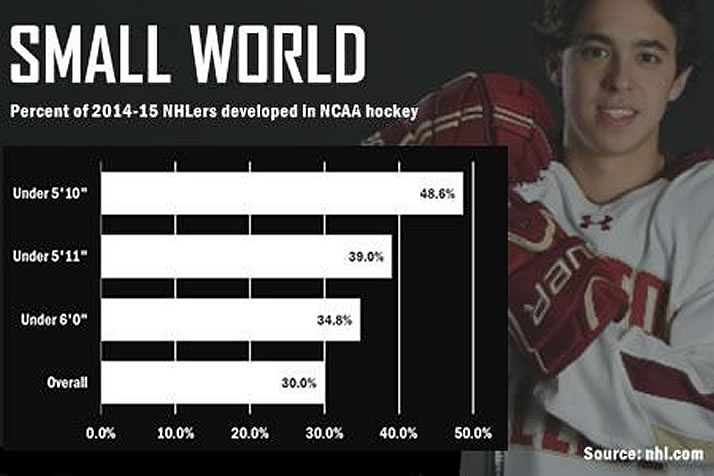


The exploits of players like Johnny Gaudreau and Tyler Johnson in the 2015 Stanley Cup Playoffs are proving that now, more than ever, you don't need size to stand out in a crowd of NHL players.
NCAA hockey doesn't produce all of these players - Johnson, for example, played in the WHL. But the numbers show that U.S. college hockey develops a disproportionate number of undersized NHLers, like Calder Trophy candidate Gaudreau.
While 30% of all NHL players played college hockey, that number rises to 34.8% when looking at players under 6-foot tall (see graphic, above). The smaller the player, the bigger the NCAA influence - nearly half (48.6%) of players under 5-foot-10 played college hockey.
Stephen Whyno of the Canadian Press looked at the growing impact (pun intended) of the little men in the game:
With all due respect to Randy Newman, short people have plenty of reasons to live and thrive in hockey today. Stricter enforcement of penalties after the 2004-05 lockout brought more speed to the game and opened the ice for more little guys than back when Theo Fleury broke the mould.
...
“The one thing about smaller guys, bigger players always have to play themselves off teams,” Lightning coach Jon Cooper said. “Smaller players always have to play themselves on teams. As a smaller player, I believe you have to set yourself apart in some aspect. You have to be better than everybody else.”
College hockey has a history of producing talent that fits that bill, from Adam Oates (Rensselaer) to Martin St. Louis (Vermont) and beyond.
|
Next Big Names? Here are five stars from NCAA hockey in 2014-15 - all under 5-foot-11 - who could make an NHL impact: Austin Czarnik, Miami (5-9) - Nifty playmaker signed with Boston. Joey LaLeggia, Denver (5-10) - Dynamic defenseman was NCHC MVP. Edmonton pick. Matt Grzelcyk, BU (5-10) - Captain, drafted by hometown Bruins, returns for senior year. Matthew Peca, Quinnipiac (5-9) - Tampa draft pick got taste of AHL after season. Kyle Rau, Minnesota (5-8) - Two-year captain had 20 goals for Gophers. |
A big reason for that is the development those players enjoy while on campus. Four years of eligibility allows them to mature until 22 or 23. The NCAA schedule allows time for strength and conditioning, so they can add muscle to their smaller frames. And the practice-to-game ratio allows them to work on their individual skills.
See More: NCAA Player Development
Infographic: Undersized Defensemen
These advantages may be most evident on defense, where NCAA hockey has developed small, skilled blueliners like Torey Krug (Michigan State), Kevin Shattenkirk (Boston University) and Dan Boyle (Miami).
A total of 66 defensemen under 6-foot tall have appeared in the NHL since 2010. Forty-eight percent of those played college hockey, and every single one stayed in school at least three years. Nearly three quarters played all four years.
College hockey isn't just a small man's game - in fact, 45% of NHLers 6-foot-6 or taller played college as well. But as smaller players make NHL headlines and perhaps earn more opportunities in Gaudreau and Johnson's wake, the NCAA will continue to produce dynamic undersized players.